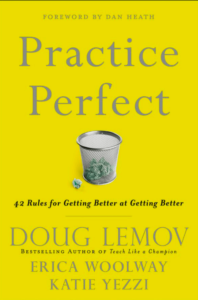Book introduction:
“Practice Perfect,” as the title hinted, is a how-to method book. I really enjoyed it and highlighted many notes. However, it couldn’t be half-long. The book chapters are not well-organized. Lemov, the author, breaks the core concepts(rethinking of practice, how to practice, using modeling, feedback, culture of practice and post-practice) into smaller and repetitious portions so that I could not connect every chapter in a straight way.
Below were some of the rules I felt applicable in this book:
Rethink practice and isolate
your skills:
Practicing in a hustle and bustle environment sometimes distracts
me from recognizing I’m learning in the wrong way. So I participate in the learning
workshops or study groups for getting feedback from the other members. I could re-examine
what skills to be sharpened through rethinking. Then I break the difficult paths
for isolated skill development.
Bright spot:
Focus on your strength. Improving your weakness is a waste
of time.
In the past, I tried to learn different domain knowledge and
skills for the sake of proving myself. However, these skills didn’t turn out to
be a competitive work advantage. As a knowledge worker, you must make effective
contributions to your cooperation.
However, honing my weakness only makes me a mediocre worker.
Why do I spend more energy on my strength?
Shorten the feedback
loop:
Implementing a small and easy change right away can be more effective
than a complex rewiring a skill. So I usually try to post my thoughts on my Facebook
after reading.
Replace your purpose
with an object:
I love to make a New Year’s resolution to improve myself
over the next months. Unfortunately, after only a few short weeks, most of them
failed. By writing a reflective journal, I know it’s not realistic. So I adjust
my goals to make them specific and measurable. For example, I want to speed up my
writing, so I use Excel to record my word count every day.




